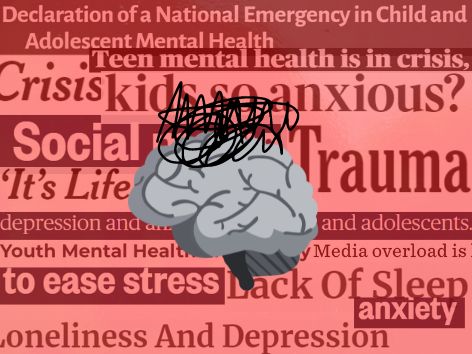
The message is clear: teenagers across the nation are struggling with their mental health. In October 2021, the American Academy of Pediatrics, along with the American Academy of Child and Adolescent Psychiatry and the Children’s Hospital Association united in declaring a national emergency in children’s mental health.
With staggering statistics and anxious adults, media attention on adolescent mental health has skyrocketed in recent years. U.S. News reported, “The Youth Mental Health Emergency Isn’t Over. Government Must Act Now.”, while The New York Times claimed, ‘“It’s Life or Death’: The Mental Health Crisis Among U.S. Teens.” Meanwhile, CBS wrote, “Teen mental health is in crisis, study shows. What can parents do?” Emergency, death, crisis; shockingly scary and heartbreaking language is being used across news headlines. But this is not the whole truth.
Teen Mental Health
While the problem is prevalent — many adolescents are struggling — in many ways, it seems as if the media refuses to cover the other side: happiness. In a survey of U.S. teens conducted by Morning Consult in the spring of 2023, 21% reported that they were much happier since the pandemic, and another 21% expressed they were somewhat happier. Similarly, teens reported a “net better” score of +11 regarding overall wellness since the pandemic.
In the familiar white walls of HBHS, teachers have observed students on both sides of the mental health spectrum. Film Studies teacher Victoria Flaherty has noticed a complex balancing act of “a life that feels a lot bigger than [her] life felt when [she] was a teenager.” Referencing students with time-consuming jobs and a social media presence with lots of expectations, it’s easy to see why this new generation would be struggling. Evidently, English teacher Lin Illingworth has seen this modern connection to a “second life or cyber life” causing heightened anxiety in students.
On the contrary, Illingworth has also found a common strength of more self-awareness that students possess. Likewise, Flaherty has noticed an “overarching example of happiness” through the openness, awareness, and expression of students to trusted adults, parents and therapists. While teens are struggling, they are also happy. Media coverage and society seem to forget this sometimes.
Negative Media Coverage
As news and reporting have modernized to online and social media platforms, headlines and articles have also slowly evolved. Driving more views and attention, negative or dramatic coverage has become the norm across the field. Mass violence, climate change, political divisions, and global conflicts seem to be the only thing discussed in modern news.
With an oversaturation of negative media, a societal term has emerged to place a label on a new activity. Known as “doomscrolling,” it is the act of spending significant time reading and exposing oneself to an excess amount of negative news. Referencing a time during the pandemic, Illingworth explained, “I remember a day where I was doom-scrolling and I sat back and said ‘you’re doom-scrolling’ and I realized what it was doing to me.” Although the pandemic has taken a back seat in headlines, new worrying topics such as the ongoing war in Ukraine have quickly taken charge. American apocalypse, scroll, manslaughter, scroll, missile attack, scroll…doomscrolling is ever present in our society.
Doomscrolling can cause news burnout and fatigue along with drastic psychological changes. After reading a negative news article, the typical “physiological response without people knowing it is almost anxiety, depression, sadness, and worry,” said HBHS Psychologist Eric Penniman. This internal impact can almost go under the radar, while still notably making a difference in an individual’s mood and productivity.
In a 2015 study on morning news, participants were separated into two groups: one that focused on negative news stories and the other that watched positive solution-focused news. The results found that watching only three minutes of negative news in the morning led to a profound 27% greater chance of reporting their day as unhappy six to eight hours later. Negativity is consuming our news, while silently poisoning our mood. News needs to change.
Media Representation of Mental Health
Negatively focused stories contribute to a larger theme of an oversaturation of harmful media and an undersaturation of representational media. In a study on media coverage of mental illness in over 400 news stories, it was reported that only 14% of news stories focused on successful treatment or recovery from mental illness. Instead, Health Affairs found that the media highlighted violence, creating a societal stigma surrounding mental illness. Illingworth explained how the media is “full of stereotypes that dehumanize mental health.” The manner in which individuals are depicted in news —especially the inclusion of stereotypes— can heavily influence societal opinions, beliefs and actions. Proper representation is not optional; it is necessary.
In recent years, there has been a societal push for more representation of all forms in the media, including mental health. Referencing Ted Lasso, a 2020 American sports comedy and drama series, Illingworth explained how “it was the first time I had ever seen anybody in the media legitimately portrayed as what a panic attack could look like.” Although seemingly simple, this groundbreaking representation shined light on an underrepresented aspect of mental health. Representational media can connect with individuals, making them feel seen, while also reducing harmful stigma and bias.
In other ways, it seems as though mental health representation has not changed at all. “Recognizing the seriousness of mental health has been around in media for a very long time,” explains Flaherty. Discussing the 1941 film Citizen Kane, Flaherty describes a “mental breakdown in a part of one of the characters because she was pushed to a limit” forcing her to “take drastic action towards her own life.” In reflection, Flaherty described how “the representation of it and the reaction to it, I felt were nearly modern, but perhaps that just shows that it’s not modern.” Even after 80 years of progression, the media representation of mental health has seemingly not modernized at all.
While the representation of mental health has remained little more than a puddle, discussion as a whole has transformed into a vibrant and rushing river. Society has normalized therapy along with emphasizing the importance of acceptance and accommodation of mental health in all walks of life. “There has been a definite positive shift in the last several years toward mental health and also working actively toward better mental health for people in schools and work and real life,” said Flaherty.
Society has also begun to recognize the nuances of mental health, focusing on how it takes different forms for different people. “Mental health matters to everyone, but it doesn’t necessarily look like a huge mental problem, a mental break, an attempt on life, or isolation from things that are loved,” said Flaherty. Instead, she elaborated, “It can look like burnout, it can look like a treat yourself day, it can look like needing to talk to a friend, it can look like weekly therapy.” It is important for the media to display the many different takes on mental health; it is equally critical to write a story on drastic mental isolation as it is to highlight an achieved goal.
Although still years behind, the media has begun to highlight happiness, the other side of mental health. Specifically on social media, short-form content has birthed a modern representation of happiness. “Hope Core” is a new trend that highlights inspiring and heartwarming moments by combining them into videos backed with relaxing music. For Flaherty, interactions with Hope Core involve generally crying over videos of dogs being reunited with their owners or even babies being cute.
This new trend can serve as a quick fix for happiness but it has not been proven to be an effective way to consume positive media. Instead, psychologists have looked at more impactful solution-focused news. This form of news disregards the cuteness of puppies and rainbows and instead highlights real-life inspiring stories of responses to problems. In featuring real-life people, audiences can connect with the story and gain insight from it. “[Solution-focused news] has been shown to affect people’s mental health much more positively than watching something negative on the news,” said Penniman. Solution-focused news is the answer to how society can positively benefit from reading a story.
The Future of Mental Health Coverage
While negative stories do exist and are important for a nuanced perspective of the world, these aspects should never detract from the positive parts of our society. Currently, negative mental health in teens is disproportionally represented in the media in comparison to positive mental health and is plagued with misinformation and harmful stereotypes. Overconsumption of such negative media has drastic psychological effects on the reader including depression and anxiety.
On the contrary, positive experiences are just as worthy of being reported on. Proper representation of mental health can reduce societal stigmas, and reading positive perspectives can benefit readers’ outlooks on life. The media is capable of making this shift to represent mental health in a positive light. The news can and needs to change.









